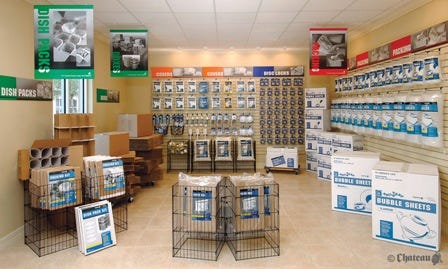Selling boxes, locks and packing materials at your self-storage facility requires more than just keeping inventory in stock. You need a plan. The best way to entice your customers to buy these items is through proper pricing and attractive displays.
November 28, 2017

By Nancy Martin Wagner
Selling boxes, locks and packing materials requires more than just keeping inventory in stock. You need a plan. The best way to entice your self-storage customers to buy these items is through proper pricing and attractive displays.
When you go to the grocery store to pick up a staple item such as milk, eggs or bread, you’re exposed to many other items you may also need. Experienced retailers strategically place additional products around their best sellers to entice customers to purchase more.
In the self-storage industry, the best sellers are usually small and medium moving boxes, locks, mattress and furniture bags, tape, packing paper by the pound, and protective bubble-wrap rolls. These should always have the biggest and best location in your retail area, however, you can benefit by placing sure-fire accessories that go with them in a suggestive display.

For example, the glass-cell and dish-cell kits that include protective foam pouches should be on display with the small boxes because they go with them perfectly and will sell. Also, put the twin-pack locks near single-pack locks so customers have the option to buy two locks that work with the same key. Another suggestion is to put new, complicated or slow-selling items at the counter where customers will see them as they check out. This gives the manager a great dialog-starter. If you display color-coded moving label kits at the counter, your customers will surely ask what they’re for, giving managers a great selling opportunity.
The Art of Plan-o-Grams
Professional retailers use a merchandising blueprint or map called a plan-o-gram to keep their retail displays consistent, organized and efficient. The plan-o-gram is a diagram of the retail space showing the location of every product and the quantity of facings for each. For example, the accompanying diagram shows how many bundles of boxes and mattress bags to have on display at all times. There should be enough space for each item to create a visual impact for the customer; small items should have many facings.
To view a sample plan-o-gram, click here.
Locks should have an allocated space with at least eight peg hooks so customers see them without having to search. The best sellers should always be the most visible because, in many cases, your customers are limited on time and want to find the product easily. When you display tape next to boxes, they’ll remember they need it, too.
The plan-o-gram system helps the manager maintain stock because everything has a place and it’s obvious when something needs to be replenished. By using a plan-o-gram, you can ensure the retail display remains consistent, and you won’t run the risk of losing a sale because something is out of stock.
When it comes to pricing your retail items, the plan-o-gram system is fantastic because you can use printed price signs in each allocated area instead of putting labels on each item. This is also a very clean and efficient way to adjust prices. Many retailers recommend you keep a price sheet at your counter listing all items and their prices with a quantity box. Then your organized customer can take it with him and plan on the items he needs for his upcoming move.
Pricing Products
Your prices should always be aligned with your competition. Every facility manager should conduct an apples-to-apples comparison in his marketing area to ensure his prices are better or similar to other retailers. If your item has special advantages over a similar product, know why and be able to explain it to customers. Here’s an example: “Our packing peanuts are a little more expensive than what you'll find at other stores because they're biodegradable, not foam.”
The general rule when determining retail pricing is to double your cost and round up or down to be competitive or better than other retailers. Also, consider offering quantity discounts that bring the customer up to the next level. For instance, price tape rolls at $2 a roll or three rolls for $5. Whether your goal is to advertise your best sellers or clear out unwanted items, put some time and thought into your retail store. Keep it simple, but attractive. Remember, your customers are shrewd buyers and they’ll appreciate your expert buying and selling abilities.
Nancy Martin Wagner is vice president of marketing for Chateau Products Inc., a lock-and-latch manufacturer specializing in the self-storage industry. The company offers disc locks and padlocks for resale, cylinder BEZEL latching systems, retail-store fixtures and packing supplies. For more information, call 800.833.9296; visit www.chateauproducts.com .
You May Also Like





